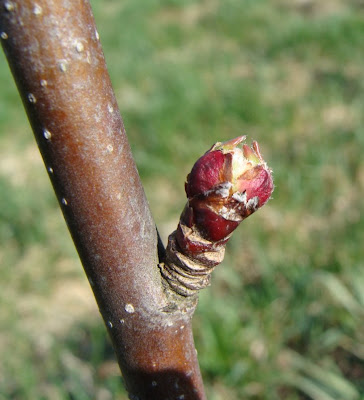
You have to look quite hard to see them, but this picture shows my first entirely greenhouse-grown seedlings. There are lettuces at the back and on the right of the shot, with some small spinach plants towards the bottom left. These were sown about four weeks ago in seed trays in the greenhouse and were just big enough to transplant into one of the raised beds today. Very proud of these little specks of green!
Next to them I've sown some land cress (
Barbarea verna) seeds and I've also planted a couple of last year's leftover Netted Gem potatoes, in hopes of getting an early crop of those. My main seed potato order will arrive in two weeks from Alberta.

Also in the greenhouse are some of the seedlings I sowed in the warmth of the house earlier in the year, including these onions (Early Yellow Globe) which are looking happier now that they're getting light from all directions.
The other day I re-sowed the peas, as the first batch had vanished completely from the
eavestroughs/gutters. This time I balanced the troughs over a corner of one of the raised beds (instead of leaving them on the floor). The peas are still in situ and are now showing signs of sprouting. I think those in the first sowing must have been stolen by mice.

Outside, the garlic is looking better than it did when the snow first melted and the
Egyptian walking onions that a neighbour gave me are poking up through the soil, too. I hadn't heard of these before, but they make new bulbs from the top of the plant, which, when they get big enough, will bend the stem down to the ground, setting down the bulbs to grow into new plants. After last year's complete failure of the onion crop, it looks like we will have plenty for 2009.
We also got around to planting the
White Birch tree (
Betula papyrifera) that was a gift from the organisers of the Green Homes Tour on Sunday. The hole we dug filled up with water quite quickly, so I was relieved to read that this native variety of birch doesn't mind growing in wet meadows!

 The children were off school for the day, so in the afternoon we took them and the dog on an excursion to the Macaulay Mountain conservation area, just outside Picton. There are trails through a steep, densely-wooded hillside (although they aren't terribly well signed and we managed to get lost towards the end!). There weren't many leaves out yet, as you can see in this photo of a Trout lily (Erythronium americanum):
The children were off school for the day, so in the afternoon we took them and the dog on an excursion to the Macaulay Mountain conservation area, just outside Picton. There are trails through a steep, densely-wooded hillside (although they aren't terribly well signed and we managed to get lost towards the end!). There weren't many leaves out yet, as you can see in this photo of a Trout lily (Erythronium americanum):
 There were quite a few Trout lilies and a number of flowers that I confidently told everyone else were anemones:
There were quite a few Trout lilies and a number of flowers that I confidently told everyone else were anemones:
 It was only when I got home and started looking them up that I realised that these little flowers are called hepaticas (Hepatica americana). Then I discovered that there are botanists who think that hepaticas should really be reclassified as anemones. So perhaps it doesn't matter too much what they're called. They were very beautiful, either way!
It was only when I got home and started looking them up that I realised that these little flowers are called hepaticas (Hepatica americana). Then I discovered that there are botanists who think that hepaticas should really be reclassified as anemones. So perhaps it doesn't matter too much what they're called. They were very beautiful, either way!





























